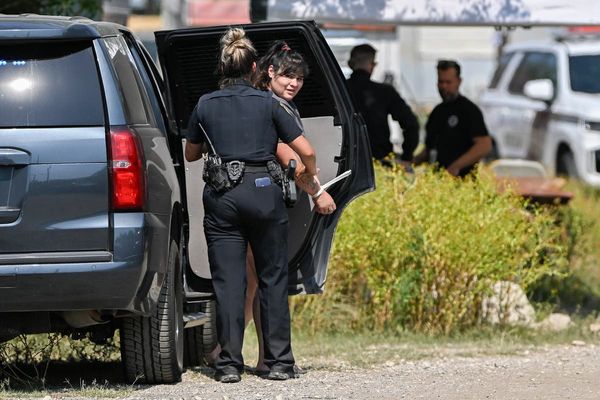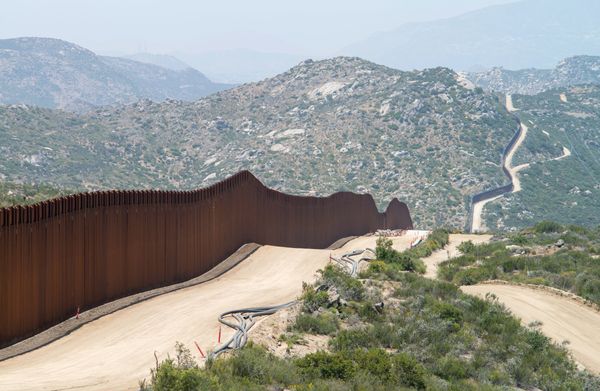
In Gaza, the ever present fear of sudden death has prompted mothers to write their children’s names on their legs and hips, to help with identification if they are killed in an airstrike.
They have no control over the Israeli war waged against them, which is very much out of the 21st century – fought from the cockpits of jets and the control rooms of hi-tech naval ships. Yet, on the streets of southern Gaza, people’s lives have been bombed back decades.

On Friday night, that bombing intensified in the heaviest strikes of the war, turning the sky orange, as mobile phone networks, internet and even satellite phones stopped working, leaving Gaza almost entirely cut off from the world.
Even before then, families displaced from Gaza City and the cities further north, which have borne the worst of the Israeli strikes, numbering several hundred a day, were surviving by collecting broken furniture and scrap wood in the streets to use as fuel for cooking. There is very little cooking gas. And without power or internet, many had already abandoned phones and televisions, underlining an atmosphere of often brutal isolation. For those who have them, radios have become the sole link to the outside world.
Fridges do not work, and food- and water-borne disease is a daily anxiety. Those who can find accommodation with friends and family crowd into their homes. Others have overwhelmed the UN-run schools used as shelters in times of war in Gaza; more than 600,000 people have converged on 150 schools.

Yet more internally displaced people have converged on open areas around hospitals, believing them to be safer, and some families have taken to sleeping in their cars.
All the time, the Israeli strikes continue, scores each hour, a bombardment that has been relentless since the militant Islamist group Hamas massacred 1,400 Israelis, most of them civilians, in a surprise attack earlier this month through the Gaza border fence.
The new phenomenon of children’s names being written on their limbs has been confirmed by images of dead children in a Gaza morgue and the accounts of doctors and parents.

In life, as in death, everything in Gaza today has become profoundly challenging.
Amr, 47, who does not want to give his family name, left Gaza City two weeks ago with his wife and two children.
“I have a Kia Sorento car. We’re in Khan Younis now staying near an UNRWA[United Nations Relief and Works Agency for Palestine Refugees in the Near East] school. We can’t sleep in the school, so we have to sleep in the car. Sometimes I’ll drive to find a place to find toilets or we’ll go to friends’ or relatives’ homes to shower every few days. It’s not a life.
“We’ve been waiting for Rafah crossing [into Egypt] to reopen so we can travel. I tried to go many times, but without success.”

With negligible humanitarian access, and about half of Gaza’s population of 2.3 million displaced in the past three weeks, Amr’s story is grimly typical.
This week, UNRWA warned that unless fuel reached Gaza, it would have to halt many of its operations, although the Israeli military has said it believes there is sufficient fuel in the territory.
“If fuel is not received into Gaza, UNRWA will be forced to significantly reduce and in some cases bring its humanitarian operations across the Gaza Strip to a halt. The coming 24 hours are very critical,” the agency said.
Crippling shortages of fuel since Israel announced it was imposing a “complete siege” mean there is little electricity, limiting the ability of ordinary Palestinians in Gaza to communicate with the outside world.

Without electricity, the water pumps that carry water to the rooftop tanks cannot function.
In the market in Nuseirat in central Gaza, where many from Gaza City have relocated, Wafa Bash, a 56-year-old mother of seven, described the challenges of daily existence.
“I come here every day to see what’s available in the vegetable market to see if I can find something to cook for the family. We can’t store things in the house because there’s no power to the fridge. So I have to come here daily.”
And shortages mean many must endure long and frightening periods queueing in the open. At the bakery in Nuseirat, that can mean up to five hours. “I’ve been waiting here for almost two hours,” said Talal Ayman, a 19-year-old student.

“I have at least another hour queueing until I reach the bakery entrance. I spend almost every day doing this to get bread. It’s so harsh. I’ve seen fights over people trying to jump the queue. I don’t know when this is going to end.”
Even though Gazans have been told by the Israel Defence Forces to move south, where it is “safer”, places like Nuseirat do not meet the usual definition of safety. This week the family of Al Jazeera’s Arabic bureau chief, Wael Dahdouh, were killed in an air strike on Nuseirat. According to Palestinian reports, the market too has come under fire.
“Prices have gone up because of shortages,” said Bash. “I’ll cook pasta today because it’s easy and quick to prepare. We still have some cooking gas from before the war. I don’t know what will happen when it’s done, but I don’t want to think about it now.
“My husband is listening to the news on the radio all the time and my kids are like a beehive. We are getting some water from a next-door tap, but we’re trying to minimise consumption to keep it for longer. All that and with airstrikes all the time.”

Wissam Yassin, a journalist who works for the US Arabic-language TV channel Alhurra, is one of the thousands sleeping outside Nasser hospital in Khan Younis. “It’s been two weeks that I’ve worked from the Nasser hospital. I sleep in the car. I drink very little water in order not to have to go to the toilet,” she told Agence France-Presse. “The bombing is all around us.”
Razan, who moved to the Rafah area after her family home in the Rimal area of Gaza City was damaged in an Israeli airstrike, described an increasing sense of desperation.
“People are cooking the old-fashioned way with wood, even using furniture for fuel. Yesterday I heard that a group of people went to one of the UNRWA stores and stole the flour there. People are sleeping wherever they can find shelter in cars, inside and outside the hospitals. Two of my uncles are renting a room inside a hospital.”

“There’s no cooking gas available now,” said Mohammed Abed, a 61-year-old in Nuseirat. “People have very few options to make bread or cook at home. I have relatives in my house, who fled from different places in Gaza city. It’s difficult to manage and feed so many mouths.
“I have a yard in front of the house; we cook on fire and make bread almost every day. We charge batteries from a next-door house who has a solar power to light the lights and recharge phones.”
For Amr, responsibility for what is happening in Gaza is spread wide. “I don’t blame one party for this. They are all responsible and blind to what is happening: Hamas, Israel, the Arab countries and US and EU countries.”







